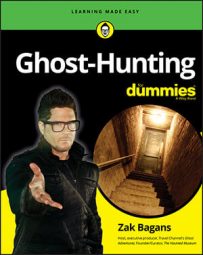I have compiled a list of what I believe are some of the most haunted places that I have personally encountered. Read on — or better yet, visit them — if you dare.
Goldfield Hotel
In the almost ghost town of Goldfield, Nevada, is the historic and very haunted Goldfield Hotel. The hotel opened in 1908 to great fanfare. Considered to be the most luxurious hotel between Chicago and San Francisco, the Goldfield Hotel appealed to society’s upper crust, making it an immediate success.Soon after the hotel opened, it was sold to George Wingfield, primary owner of the Goldfield Consolidated Mines Company, and hotel entrepreneur, Casey McDannell, who managed and operated the hotel.
Reportedly, several ghosts are at the old hotel, the most famous of which is a woman named Elizabeth. According to the legend, Elizabeth was a prostitute that George Wingfield visited frequently. When she turned up pregnant, she claimed the child was Wingfield’s, who for a while paid her to stay away, fearful of how the scandal might affect his business affairs.
However, when she could no longer hide the pregnancy, Wingfield was said to have lured her into room 109 of the hotel, where he chained her to a radiator. Supplied with food and water, she was left there until her child could be born. Some say that Elizabeth died in childbirth, but others contend that Wingfield murdered her after the child was born. Her baby was then thrown into an old mining shaft. Afterwards, rumors abounded that Elizabeth continued to visit Wingfield, and the sound of a crying child could sometimes be heard coming from the depths of the hotel.
The legends state that Elizabeth’s apparition has been seen with long flowing hair, wearing a white gown, and looking terribly sad as she walks the hallways, calling out to her child. Others have reported her being sighted in room 109, which is often described as being intensely cold.
Elizabeth does not walk the hotel alone. Ghosts of two suicides haunt rooms on the third floor. Near the lobby staircase, the spirits of children are said to play pranks on visitors. And then there is the ghost of George Wingfield himself, who makes his presence known with cigar smoke.
Many believe that the Goldfield Hotel is a gateway to the next world. True or not, it has more than its share of strange phenomena, including footsteps, unexplained noises, and even poltergeist activity, as was seen during one of the Ghost Adventures investigations of the building.
Washoe Club
During the days when Nevada’s Comstock Lode was turning miners into millionaires, the Washoe Club in Virginia City was created by mining magnates, artists, and writers as a place of luxury. It soon gained a reputation throughout the West as a place to find extravagant accommodations, but it began as an idea.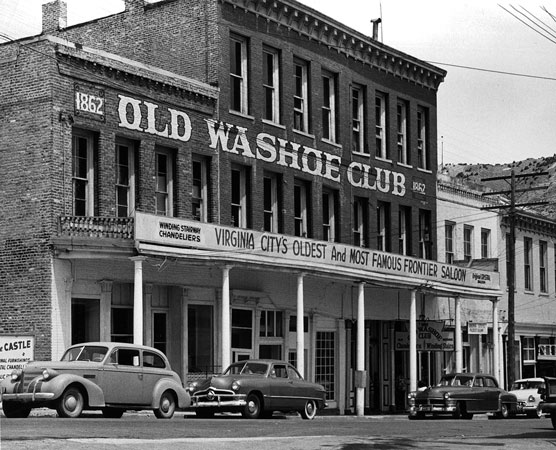 The Washoe Club.
The Washoe Club.From February 1875 through 1881, the Washoe Club went through various stages of prosperity. A disastrous underground fire in 1881 wreaked havoc on the production of mines and on the ability of the Washoe Club members to continue to indulge in luxury.
A number of ghostly stories — and first-hand accounts —surround this place. The notoriety of the Club as an actively haunted place began back when the first Ghost Adventures documentary film aired on television. It included a scene at the Washoe Club where an apparition walked across the floor for a mind-boggling seven seconds.
There are tales of a brothel that used to be on an upper floor. The story goes that a blonde prostitute was murdered on the third floor, and her killer took his own life in despair. There was also a young girl allegedly killed in the basement. Many have reported seeing the ghost of the prostitute on the spiral staircase that once led up the wealthy men’s club upstairs. In fact, she has been seen so many times that patrons of the new club began calling her Lena. She has also been seen in front of the wall across from the bar.
Anyone who visits the Washoe Club will take something away with them — whether it is an appreciation of the history or a paranormal encounter. It is a place where I have never been disappointed.
Crescent Hotel
In the remote resort town of Eureka Springs, Arkansas, stands the gothic Crescent Hotel. Called by some the Grand Old Lady of the Ozarks, the hotel has served as many things over the years, and yet strangely, each incarnation has contributed to the legion of phantoms believed to walk the corridors of the building.The Crescent Hotel was built on the ridge of West Mountain between 1884 and 1886. The Crescent Hotel drew people from all over the country for the next decade, but as times changed, the wealthy began to have less interest in the “healing waters” and business for the entire town began to decline. In an effort to keep the hotel open, it was used as the Crescent College and Conservatory for Young Women, starting in 1908. The school became an exclusive academy for wealthy young ladies. The school closed in 1924, and the hotel shut down five years later.
On July 31, 1937, the hotel was sold to Dr. Norman Baker, a quack and flim-flam artist who claimed to have a cure for cancer. He spent a grand sum remodeling it into a hospital and then moved in with his medical staff and 144 patients.
While scores of patients succumbed to their cancer, no reports exist to say that anyone was actually killed by Baker’s treatments. Local rumor, however, had a different story to tell. The legends say that when remodeling was done at the hotel in later years, dozens of human skeletons were discovered hidden within the walls.
Truth or fiction, federal authorities caught up with Baker, and he was charged with using the mail to defraud the public about his false medical claims. He was convicted in 1940 and sentenced to four years in Leavenworth. The hospital closed, and Baker vanished into history.
The brooding old hotel stayed closed until 1946, when new investors took it over and began trying to restore the building. It wasn’t long before the ghost stories began. Staff members began to receive frequent reports of strange happenings in the rooms and hallways. Guests have awakened in the night to find figures standing over them. Spirits have been seen sitting quietly in the lobby, vanishing when approached. A woman in a nurse’s uniform has been seen pushing a gurney down a hallway later at night. An apparition near the staircase has been identified as Norman Baker himself, perhaps still trapped in the building where he harmed so many sick and dying people.
Trans Allegheny Lunatic Asylum
The story of the Trans-Allegheny Lunatic Asylum, formerly Weston State Hospital, is a familiar one in the long line of woeful tales from American asylums. It was a designed to provide a safe place for the mentally ill, and like so many others, began with good intentions, only to become overcrowded and undesirable in the 20th century. But if one thing sets this place apart from others like it, even those with a reputation for being haunted, it is that the place once known as the Weston State Hospital is said to be infested with ghosts.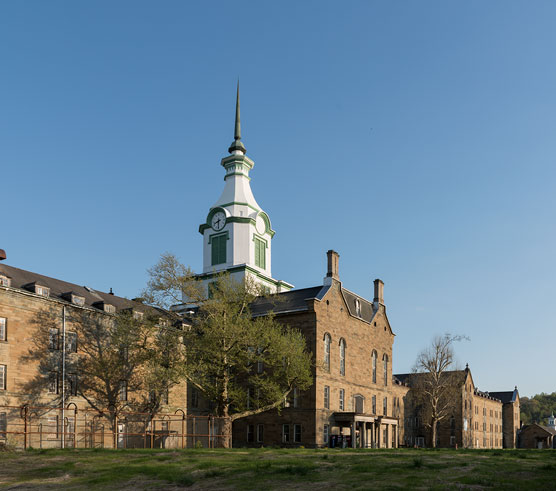 The Trans Allegheny Lunatic Asylum.
The Trans Allegheny Lunatic Asylum.When the Civil War began in April 1861, the Weston State Hospital was still in the early stages of construction. Weston was invaded by the Seventh Ohio Volunteer Infantry, who used portions of the completed hospital as a camp.
During the war, the area where Weston was located became part of the newly organized West Virginia, which provided funds for work on the hospital after the war. The Trans-Allegheny Lunatic Asylum was finally completed in 1881. Its name was changed to Weston State Hospital in 1913 in an effort to remove the stigma caused by the words “lunatic” and “asylum.”
Originally designed to house just 250 inmates in peaceful solitude, the hospital held 717 patients by 1880. The numbers continued to climb into the 1950s, when more than 2,600 patients were packed into filthy, overcrowded conditions. The asylum was overcrowded, which led to other problems, including violence.
By the 1980s, the hospital’s population was finally reduced due to changes in the treatment of mental illness. The hospital was finally closed in 1994 and sold at auction in 2007. New owners renovated the crumbling building and began offering historic tours. After the construction work began — and the tourists began to arrive — those who spent any amount of time in the asylum began to realize that the living were not alone in the old hospital. The dead were present, and they were making themselves known.
The Trans-Allegheny Lunatic Asylum was made up of different wards to facilitate the treatment of various kinds of patients. On the third floor, Wards C and F held the more physically violent men and women, with only a single locked door separating the two wards from each other. Many who have visited Ward F have reported being touched on the shoulder, pinched, or had their clothing pulled and hearing, whispers and, most eerily, the sound of the creaking wheels of gurneys being pushed down the empty corridors.
In Ward 2, located on the second floor, victims of a double suicide and a brutal stabbing have been said to wander the dark hallways, their dragging footsteps clearly being heard as they shuffle along the dark passageway. Witnesses claim to experience an icy grip of cold as the footsteps brush past, only dissipating when the sound is no longer heard.
If a single floor is more infamous than all others, it’s the fourth floor, which was reportedly haunted even in the days when the Weston State Hospital was still in operation. The sounds of banging, footsteps, maniacal laughter, and haunting screams have been heard all over the floor. It is a place known to be so eerie that hospital workers refused to go up to the fourth floor without an escort.
One of the haunts of the fourth floor is said to be the spirit of a nurse. Legend has it that she was murdered decades ago by a patient who hid her body in an unused stairwell for nearly two months before her body was discovered.
Without a doubt, the most famous lingering spirit of Trans-Allegheny Lunatic Asylum is that of the young girl who has come to be called Lilly. She appears to be a child, perhaps three or four years of age. She wanders the hallways of the old hospital and seems particularly active when visitors ask her to play. No one knows who she was, although numerous legends surround this lost little soul. A tour guide playfully rolled a ball down a hallway for her one night, only to have it abruptly change directions and return to them by some unseen force.
Queen Mary
The Queen Mary, shown in the following figure, was commissioned in 1934 and for many years was the undisputed ruler of the oceans. She set sail on her maiden voyage in May 1936 and quickly became known as the ultimate form of international travel.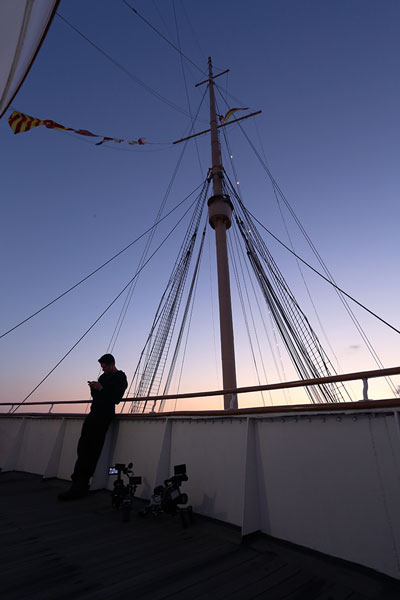 ©Travel Channel.
©Travel Channel.The Queen Mary.
In 1939, the British government commandeered Queen Mary into military service. They gave her a coat of gray paint and started using her to transport troops. The Queen Mary was able to avoid the enemy torpedoes during the war, she was unable to avoid tragedy.
The horrific event occurred on October 2, 1942. The ship was sailing on a choppy ocean around the north of Ireland. She carried 10,000 American soldiers, bound for the Clyde River, where the men would disembark. Tragically, Queen Mary collided with a British warship, HMS Curacoa, killing 338 of the men on the other vessel. Queen Mary suffered only minor damage, and there were no injuries aboard the liner.
After that, she served unscathed for the remainder of the war. Her post-war service was largely uneventful. In October 1967, Queen Mary steamed away from England for the last time. She ended her 39-day journey in Long Beach, California. The city had purchased the old liner, and she would be permanently docked as a floating hotel, convention center, museum, restaurant — and one of the most haunted places in America.
In addition to the wartime accident that caused Queen Mary to collide with another ship, other mishaps and bizarre deaths aboard claimed lives and left lingering spirits behind. Several members of the crew who died in various bizarre accidents are claimed to haunt the ship.
A woman in white haunts Queen Mary, usually lurking around the main lounge in a white, backless evening gown. The stories say that she usually strolls over to the grand piano as if listening to music only she can hear or dances alone for a few moments before vanishing without a trace.
Security guards, crew, staff members, and visitors have all been troubled by incidents that seem to have no explanation. Doors open and close on their own. They are locked one moment and then standing wide open the next, triggering alarms in the security office. This happens most often near the swimming pool and while the guards always look for the intruders, no one is ever found. Other reports of unexplained happenings include strange noises like footsteps when no one is there, banging and hammering like work being done on equipment, voices, cold spots, inexplicable winds that blow through areas that are closed off, lights that turn on and off, and more.
The strange events aboard Queen Mary continue, and it seems certain that events of the past have left an indelible impression on the decks, corridors, and cabins of the ship. They repeat themselves, over and over again, and create a haunting that is rivaled by few others in the annals of the supernatural.
Pennhurst State School
The sprawling Pennhurst State School and Hospital was one of many mental hospitals that became overcrowded. It had opened in 1908 as the Eastern Pennsylvania Institution for the Feeble Minded and Epileptic. It was meant to be self-sufficient, a small community of its own with a power plant, farm, hospital, morgue, barber shop, and firehouse.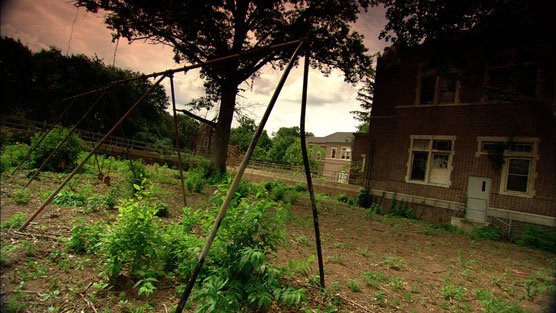 ©Travel Channel.
©Travel Channel.Pennhurst State School and Hospital.
It had been designed to house no more than 500 patients, but by 1912, the institution was severely overcrowded, and staff members were unable to give proper care to each patient. This led to terrible abuses.
Mistreatment and inhumane and dangerous conditions continued until 1968, when a new report about the hospital inspired a legal fight to correct the problems. The case went on for almost two decades before Pennhurst was finally closed.
When one considers the dark and harrowing past of the institution, it comes as no surprise that the Shame of Pennsylvania” has a reputation of being one of the most haunted places in the country. Today, the old asylum is shrouded in ghost tales and reports of paranormal activity. Visitors have claimed to hear voices, shrieks, and murmurs of pain from former inmates of the facility. The hauntings are terrifying for multiple reasons. Aside from the typical fear of the paranormal, the ghosts of Pennhurst serve as a collective reminder of just how cruel society can be toward its own members.
Numerous investigations have taken place at Pennhurst — including those conducted by Ghost Adventures — and evidence of spirits has been obtained in the form of video, photographs, and eerie messages through EVP. Shadow figures and apparitions have been seen in various buildings. Objects have been hurled through the air, and many visitors claim to have been touched, pushed, and pinched by unseen hands. Some have also reported hearing the sounds of sinks being turned on and toilets flushing, even though no running water or bathroom fixtures are in the building.
Bobby Mackey’s Music World
The building that stands today as Bobby Mackey’s Music World has a long and bloody history in the northern Kentucky and Cincinnati area. It started out as a slaughterhouse in the 1850s. Only a well that was dug in the basement, where blood and refuse from the animals was drained, remains from the original building. The slaughterhouse closed in the early 1890s, but it gained lasting notoriety a few years later after the decapitated body of a young woman named Pearl Bryan was found nearby. The murder trials that followed were some of the most spectacular in the state and led to the hanging of the two killers.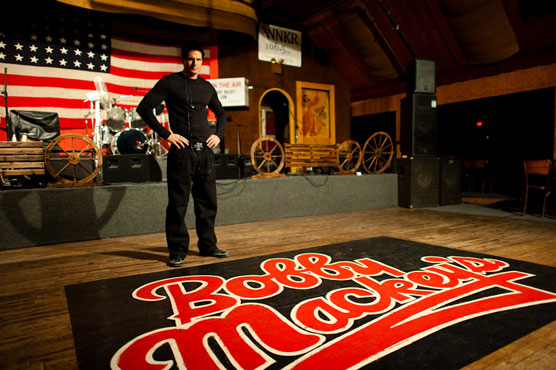 ©Travel Channel.
©Travel Channel.Bobby Mackey’s Music World.
The murderers refused to say what had happened to Pearl’s head. Many believe it vanished into the well at the slaughterhouse.
After the murder, the building was silent and empty for many years. It was eventually torn down, and a roadhouse was constructed on the site. During the 1920s, it was a speakeasy and popular gambling joint.
After Prohibition ended in 1933, the building was purchased by E.A. Brady, who turned the building into a thriving tavern and casino. After pressure from mobsters in Cincinnati that led to voilence, Brady sold out to the gangsters.
The building re-opened as a nightclub called the Latin Quarter. It was during this period that the legends about the building gained another vengeful ghost. According to the stories, the daughter of the club’s owner, a young woman named Johanna, fell in love with one of the singers who was performing there and became pregnant. Her father had the singer killed. Johanna became so distraught that she attempted to poison her father. She failed but did succeed in taking her own life. Her body was later discovered in the basement of the club. According to the autopsy report, she was five months pregnant at the time.
Business did not fare well after this. During the early 1950s, new owners of the bar were arrested several times on gambling charges. In the 1970s, it became known as the Hard Rock Café, but authorities closed it down in early 1978 because of some fatal shootings on the premises.
In 1978, Bobby and Janet Mackey purchased the bar. Carl Lawson was the first employee hired by Bobby Mackey. He lived alone in an apartment in the upstairs and began reporting that he was seeing and hearing bizarre things in the club.
Lights turned on and off, the jukebox turned on by itself, even when unplugged, and doors unlocked on their own. The first ghost that Lawson spotted in the place was that of a dark, very angry man behind the bar. A short time later, Lawson began to experience visions of a spirit who called herself “Johanna.” She would often speak to Lawson, and he was able to answer her and carry on conversations. The rumors quickly started that Lawson was “talking to himself.” Lawson claimed that Johanna was a tangible presence, though, often leaving the scent of roses in her wake.
Odd sounds and noises often accompanied the sightings, and Lawson soon realized that the spirits seemed to be the strongest in the basement, near an old-sealed up well that had been left from the days when there was a slaughterhouse at the location. Although he wasn’t a particularly religious man, Lawson decided to sprinkle some holy water on the old well one night, thinking that it might bring some relief from the spirits. Instead, it seemed to provoke them, and the activity in the building began to escalate.
Stories from staff members and customers attracted the attention of writers and ghost enthusiasts, who came to regard the bar as a place they had to visit, at least once. Many came and were too frightened to return.
Strange activity continues to occur at Bobby Mackey’s Music World, despite several attempted exorcisms of the site. It’s as though the dark and bloody history of this place refuses to let go of the hold that it maintains on the present. And that bloody past will likely continue reaching out from the grave for many years to come.
Winchester Mystery House
Legend has it that the story of the Winchester Mansion, shown in the following figure, began after the death of the husband and daughter of Sarah Pardee Winchester, a young woman from a wealthy New Haven, Connecticut, family. Her husband, William, was the heir to the Winchester rifle fortune and left his widowed bride very well off.After the death of William and their daughter, Annie, Sarah became a recluse, teetering on madness. She grieved deeply, and like many others at the time, she visited a spiritualist medium, hoping for comfort. However, the medium had a dire warning for her — there was a curse on the family, caused by the thousands of deaths attributed to the repeating rifle that the Winchester company had invented. Sarah was told that she needed to start a new life and build a home for the spirits that had fallen because of the terrible weapon. If she continued to build the house, she would live. If she stopped, she would die.
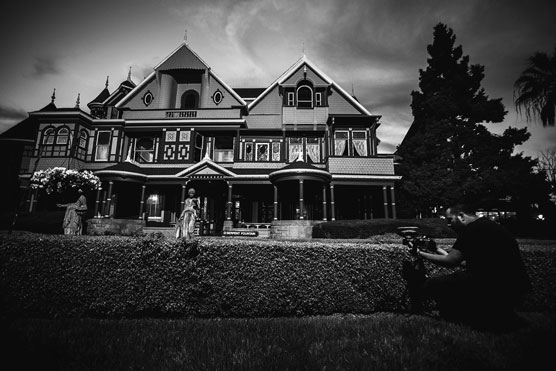 ©Travel Channel.
©Travel Channel.Winchester Mansion.
Shortly after the séance, Sarah sold her home in New Haven and, with a vast fortune at her disposal, moved west to California. In the Santa Clara Valley in 1884 she found a six-room home under construction and convinced the owner to sell it to her, along with the many acres of land that it rested on. She tossed away any previous plans for the house and started building. For the next 36 years, they built and rebuilt, altered and changed, and constructed and demolished one section of the house after another.
Sarah remained a recluse in San Jose. In all the years that she lived in the city; she was only seen outside her walls one time.
In April 1906, the house was badly damaged by the San Francisco earthquake. It took workmen hours to rescue Sarah from the room in which she had been sleeping.
On September 4, 1922, Sarah died in her sleep at the age of 83. In time, the house was sold as a tourist attraction. It initially was advertised as having 148 rooms, but the floor plan was so confusing that every time a room count was taken, a different total came up. Today, the house has been declared a California Historical Landmark and is registered with the National Park Service as “a large, odd dwelling with an unknown number of rooms.”
Based on the haunting activity that is still reported there, the Winchester Mystery House seems to have more than its share of ghosts.
Some of the first paranormal reports occurred back in the 1970s, when visitors and staff members began reporting strange sounds, footsteps, and voices that could not be explained.
Staff members have the most compelling tales of spirits in the house. Many of them have claimed to see the ghost of Sarah herself among the maze of rooms.
A security guard for the house once admitted that they often have a lot of false alarms at the house, with the security system being tripped, even though no one is ever found inside. Strangely, when they go to investigate, the alarms are usually found to have been triggered from the inside, even though the exterior alarms have not been bothered. Security guards have also reported banging doors, mysterious voices, cold spots, and doorknobs that turn by themselves.
There is no question that this is one of the most unusual homes in the entire country, and, if all the stories are to be believed, it is one of the most haunted houses, too.
Waverly Hills Sanitorium
America was Tuberculosis ravaged America during the 1800s and early 1900s. The idea of seeking “healthy air” gave rise to the expansion of sanatoriums. Hundreds of thousands of people perished within the walls of the hundreds of hospitals, which could be found in almost every town, county, and state across America.In 1900, Louisville, Kentucky, had one of the highest tuberculosis death rates in America. To try to contain the disease, plans were made for a two-story wooden sanatorium on a windswept hill in southern Jefferson County. The land where the hospital was built had been purchased by Major Thomas H. Hays in 1883, and he constructed his family home on the hilltop. He called it Waverly Hill.
An initial wooden hospital, with open air pavilions and tents for the patients, opened in 1910. It eventually proved inadequate. More construction was completed, but it was not until 1924 that work began on the Waverly Hills Sanatorium that still stands today. It opened two years later.
Treatments for tuberculosis were sometimes as bad as the disease itself. While the patients who survived both the disease and the treatments left Waverly Hills through the front door, many others left through what came to be known as the “body chute.” This tunnel was constructed at the same time as the main building, and it traveled 500 feet to the railroad tracks at the bottom of the hill. The tunnel allowed workers to enter and exit the hospital and supplies to be transported to the hospital.
Staff members began using the motorized cart to discreetly lower the bodies to the bottom of the hill and into waiting hearses or onto a passing train.
Some claim that tens of thousands died there, but records show that approximately 6,000 people died at Waverly Hills between 1911 and 1961. It may not be as many as some legends claim, but it is still a tremendous number of deaths to have occurred in a single structure.
Waverly Hills closed in 1961.
A year later, the hospital reopened as Woodhaven Geriatrics Sanitarium. The reputation of the place suffered after allegations of abuse and patient mistreatment. Budget cuts led to horrible conditions, and in 1982, the facility was closed by the state of Kentucky.
The buildings and land were auctioned off and changed hands many times over the course of the next two decades. It was finally sold to the current owners in 2001.
The former hospital soon gained a reputation for being haunted, and stories began to circulate of resident ghosts. Visitors told of slamming doors, lights in the windows when no power was in the building, strange sounds, and eerie footsteps in empty rooms.
Perhaps the greatest — and most controversial — legend of Waverly Hills was connected to the fifth floor of the building. Room 502 is where, according to the stories, people had seen shapes moving in the windows and had heard disembodied voices.
According to the stories, a unmarried and pregnant nurse committed suicide by hanging herself from the light fixture in room 502 in 1928. In 1932, another nurse who worked in the same room jumped from the roof to her death.
Literally hundreds of paranormal investigations have been conducted at Waverly Hills, including those with the Ghost Adventures crew. Visitors, volunteers, and investigators have experienced ghostly sounds, heard slamming doors, saw lights appear in the building when there should have been none, had objects thrown at them, have been struck by unseen hands, have seen apparitions in doorways and corridors, and much more.
This place can turn just about anyone into a believer in ghosts.
The Haunted Museum
I don’t think that I could have picked a better location for The Haunted Museum, shown in the following figure. The 1938 mansion, owned by prominent Las Vegas businessman Cyril S. Wengert, already had a history of ghosts when I bought it.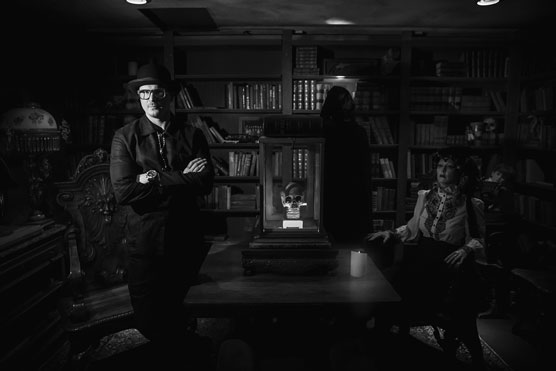 ©Courtesy of Zak Bagans, The Haunted Museum.
©Courtesy of Zak Bagans, The Haunted Museum.At the Haunted Museum.
Soon after, I heard from the State Bar of Nevada — the attorneys who owned the place — that the house was very haunted. I knew right then that my prayers of finding a historic building had been answered. I got inside and realized the first time I walked through it that I could feel spirits. And then I learned that all the employees would line their offices with salt at the door because many of them had been personally affected by attachments that followed them home. I have since discovered that the house was abandoned in the ’70s and it became known as the “witch house” because of the dark rituals that took place in the basement.
My interest in a museum dates back to my initial interest in the paranormal as a child. For 15 years before opening The Haunted Museum, I traveled the world investigating the paranormal.
The objects I have collected are placed in the museum in a way that hopefully doesn’t put people at risk, but I can’t guarantee that. That’s why everyone who comes in must sign a waiver. Since the museum has been open, hundreds — probably thousands — of people have been affected by the objects inside. But people are aware of the risk when they enter the rooms. The Haunted Museum is a collection of dark and light, and it’s a place of curiosity for people to come and maybe have an experience.

